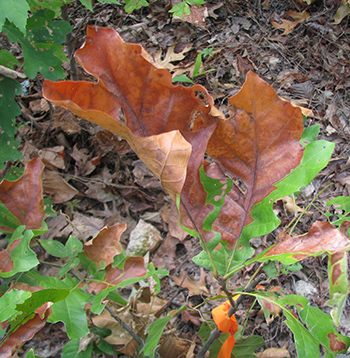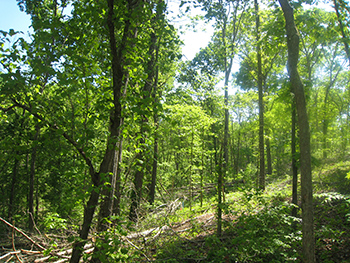Drought Impacts on Forests

Drought can have significant impacts on tree health. Photo by: Kyle Cunningham, University of Arkansas Division of Agriculture
Dry periods in the climate are a fact of life in Arkansas. These conditions may occur over a portion of the year, such as late summer, or may persist throughout a year. It is also common for drought to persist over periods of years. Arkansas' forests contain tree species that are often adapted to hot dry conditions over a period of time, particularly in the Ozark and Ouachita regions.
Many of the upland oaks, hickories, pines (e.g. shortleaf pine) and other tree species are well adapted to drought periods. The concern for tree health is higher when drought periods persist for long time periods or recur rapidly over a period of years. Lengthy drought periods can stress even the best adapted tree species and reduce tree health and vigor.
Along with the reduced health and vigor, trees become more susceptible to damaging agents, such as insects and diseases. All of these conditions combine together to form a "complex" and can lead to impacts on trees such as "oak decline" - a reduction in tree health due to a complex interaction of environmental stresses and pests -. These impacts can be even more significant in aging forests (which are common in Arkansas) and/or in dense forests. Specific impacts to forests from these occurrences include:
- Reduction in tree quality and value
- Losses due to tree mortality
- Reduced aesthetic values
- Reduced mast production for wildlife
- Increased wildfire risks
- Reduced recreational values
- Reduced environmental values

Thinned forests are more resilient to drought effects. Photo by: Kyle Cunningham, University of Arkansas Division of Agriculture.
Protecting Your Trees Against Drought
Drought stress can impact both natural forests and yard trees. Often yard trees are more susceptible than their native counterparts. It is common for yard trees to have limited room for roots and poor soil conditions. They also often have large crowns which increase the leaf area and water demand. A small root system and a large crown will increase stress on a tree.
While there is no magic bullet to defend trees from drought, the best way to protect against drought is to actively manage a forest for improved tree health and vigor. High vigor, healthy trees will have balanced crowns and root systems to help obtain water and nutrients that are critical for surviving droughts. Steps to take to protect against drought impacts include:
- Plant tree species that are native and/or well adapted to your local area (e.g. shortleaf pine in north Arkansas).
- Thin woodlands to remove low vigor,more susceptible trees and reduce overall water demand.
- Remove dense weedy brush to protect against wildfire.
- Do not damage root systems through soil compaction or root pruning.
- Monitor for non-native and invasive pests and take steps to control them.
Drought stress is a real threat to forest and urban trees in Arkansas. Furthermore, potential climate shifts toward warmer and dryer conditions for extended periods of time would certainly further impact forests. Taking steps ahead of time will provide the best protection against drought stress events. During a drought they should certainly be followed. Being proactive and planning ahead will always provide the most protection.
Publications
- Why are My Trees Dying?
Dr. Jon Barry discusses drought impacts on trees..
- Irrigating Trees During Drought.
A publication from University of Missouri Cooperative Extension Service on irrigation methods.